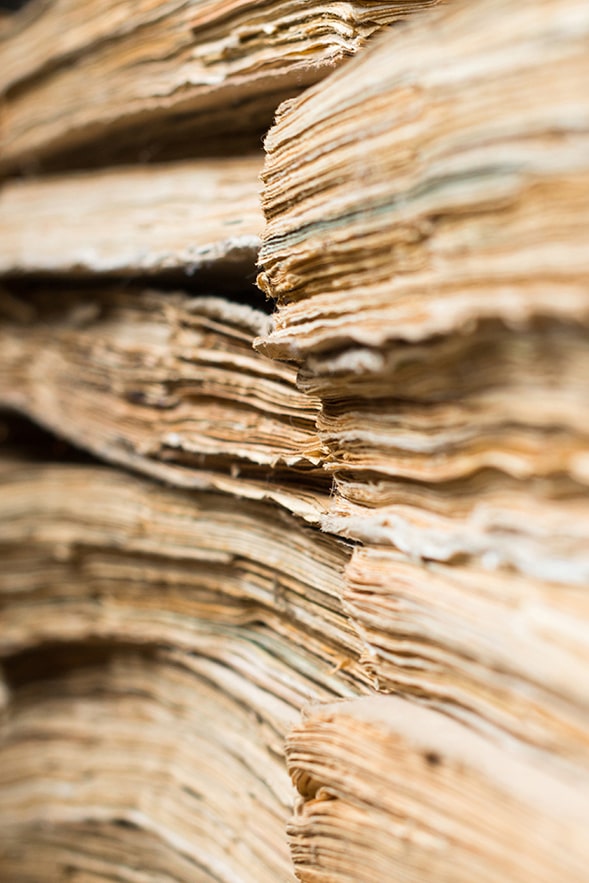The versatility of colloidal silica has made it essential for the modernization of beer, aircraft parts, and more
By Michael Eisenstein, C&EN BrandLab contributing writer
The 6,000-year-old Mehrgarh amulet isn’t much to look at—a somewhat misshapen copper wheel just under an inch in diameter, with six spokes projecting from a central hub. But the historical importance of this artifact, which archaeologists recovered from Pakistan in 1985, is undeniable: it represents the oldest known example of a metalworking technique known as investment casting.
Today, manufacturers use investment casting to produce parts for jets and automobiles. Colloidal silica has played a critical role in adapting this process for precision manufacturing with contemporary alloys. Indeed, this is just one of several examples of how colloidal silica has helped modernize ancient techniques. A market analysis published by Research Reports World earlier this year predicted that the global market for colloidal silica products will grow to $1.2 billion by 2025. This number represents an increase of over 20% from 2018, a rise that reflects the versatility of a material that has assumed a central role in producing machinery, architectural materials, beverages, and more.
Beating the heat
Neolithic artisans built metalcraft ornaments like the Mehrgarh amulet from wax forms. The form was coated in a layer of heat-resistant plaster. The wax was then melted away, leaving behind a hollow shell into which molten metal was poured. This ancient version of investment casting is accordingly known as the “lost wax” process.
Neolithic artisans built metalcraft ornaments like the Mehrgarh amulet from wax forms. The form was coated in a layer of heat-resistant plaster. The wax was then melted away, leaving behind a hollow shell into which molten metal was poured. This ancient version of investment casting is accordingly known as the “lost wax” process.
This method remained largely the domain of artisans until the late 1930s and entered the industrial realm in World War II. In the pursuit of aircraft that could fly farther and faster, Allied engineers were racing to build the first generation of jet engines. This required manufacturing precision-crafted shapes from rugged metal alloys with ultrahigh melting points. Traditional plaster molds are ill suited for such extreme temperatures, but ceramics reinforced with an extremely heat-tolerant material, such as colloidal silica, allowed engineers to produce the required molds.
In so-called precision investment casting techniques, a wax model of the desired part—for example, a turbine blade—is repeatedly dipped into a bath of ceramic stucco, which hardens into a solid shell. Colloidal silica is an essential part of this shell, acting as a binding material that creates a continuous, rigid structure that can withstand temperatures of thousands of degrees Celsius. The wax is then melted away and the molten alloy is poured in, after which the mold is cracked open to liberate the blade.
This approach can achieve remarkably fine, sub-millimeter-scale detail; even a wayward fingerprint left on the wax can appear on the final metal piece. Engineers can also attain exceptional smoothness, ensuring consistent and reproducible performance from each part.
In aerospace, precision investment casting is typically performed with nickel- and cobalt-based alloys, but it is also used in other industries with application-specific alloys. For example, biomedical implants for hip and knee replacements are typically cast from titanium, a strong and lightweight metal that has a melting point of over 1,600 °C, which makes it challenging to craft with other techniques.
A clear solution
The history of beer far predates the earliest use of investment casting, with the recent discovery of what archaeologists believe to be a 13,000-year-old brewery in Israel. As with the lost-wax process, the fundamentals of fermentation and beer production have remained fairly consistent over the millennia, although brewers have devised sophisticated strategies to improve the quality of their product—including the use of colloidal silica.
The history of beer far predates the earliest use of investment casting, with the recent discovery of what archaeologists believe to be a 13,000-year-old brewery in Israel. As with the lost-wax process, the fundamentals of fermentation and beer production have remained fairly consistent over the millennia, although brewers have devised sophisticated strategies to improve the quality of their product—including the use of colloidal silica.
Brewing produces debris in the form of leftovers from yeast, hops, and malt. These remnants leave beer murky and can distort the flavor of an otherwise refreshing beverage. According to Carlos Bravo, technical service manager at W. R. Grace & Co., this issue has become especially problematic with the soaring popularity of extra-hoppy varieties like India pale ales. Many such beers rely on a technique called dry hopping, in which brewers add hops near the end of the brewing process. “This creates a lot of suspended by-products and a lot of turbidity,” Bravo says.
Many craft brewers now use colloidal silica to remedy this problem, taking advantage of a process known as flocculation. Colloidal silica particles typically carry an electrical charge. When added to a batch of beer, these particles attract oppositely charged impurities floating in the mix to form clumps—or “flocs”—that precipitate out of solution. Beer makers can remove the sediment by decanting the liquid and pouring off the clear beverage, leaving the precipitate behind. This approach is often simpler and more efficient than other clarifying approaches, such as centrifugation or filtration, according to Bravo. “You can reduce your beer losses and get good results from your treatment without requiring much capital expenditure,” he says. A similar approach is sometimes used in the production of other fermented beverages, such as wine and ciders.

Archaeologists discovered what they believe to be a 13,000-year-old brewery at this site in Israel. The fundamentals of fermentation and beer production have remained fairly consistent over the millennia.
Credit: Getty Images

The 6,000-year-old Mehrgarh amulet, discovered at an archeological site in Pakistan, represents the oldest known example of a metalworking technique known as investment casting. Today, manufacturers use investment casting to produce parts for jets and automobiles.
Credit: D. Bagault/C2RMF

Paper is believed to have been invented 2,000 years ago in Han dynasty China. The first papermakers simply passed a slurry of wood pulp through a fine fabric mesh to trap solids and eliminate unwanted water.
Credit: Shutterstock

The headquarters of W. R. Grace, maker of LUDOX® colloidal silica. The material’s versatility has made it essential for the modernization of beer, aircraft parts, paper, and more.
A coat for all seasons
Compared with beer and even investment casting, papermaking is a relatively young endeavor, dating back roughly 2,000 years. In Han dynasty China, the first practitioners simply passed a slurry of wood pulp through a fine fabric mesh to trap solids and eliminate unwanted water. But since the late 20th century, modern papermakers have added colloidal silica to the mix to bind and flocculate these solids, achieve more efficient drainage, and produce sturdier sheets.
Compared with beer and even investment casting, papermaking is a relatively young endeavor, dating back roughly 2,000 years. In Han dynasty China, the first practitioners simply passed a slurry of wood pulp through a fine fabric mesh to trap solids and eliminate unwanted water. But since the late 20th century, modern papermakers have added colloidal silica to the mix to bind and flocculate these solids, achieve more efficient drainage, and produce sturdier sheets.
Colloidal silica is also used at the last stages of the papermaking process, as a posttreatment that adds friction and prevents sheets from slipping and sliding against one another. But this is just one context in which these particles improve the surface characteristics of materials.
When DuPont launched the LUDOX® colloidal silica product line in 1948, floor wax was among the first generation of consumer products in which it appeared. Steve Broadwater, lead technical service manager at W. R. Grace & Co., notes that these particles are still used in protective coatings for floors. “One property that colloidal silica can improve is indentation resistance,” he says. “For example, picture a gym floor where people are walking across it with cleats.”
Such wood coatings are particularly common in industrial settings. Many wood coatings contain colloidal silica, which serves as an anti-blocking agent, Broadwater notes. The coating confers resistance to scratches and marks while preventing newly made parts from sticking together. “That way, you can stack articles while they’re still warm and speed up your manufacturing throughput,” he says.
Toughness aside, Broadwater points out that contemporary demand for colloidal silica–based surface coatings is fueled by environmental concerns. For instance, older protective coatings often use solvents that evaporate as toxic volatile organic compounds (VOCs). Many industries are therefore turning to water-based coatings as an environmentally-friendly alternative. But on their own these greener products tend to be softer—an undesirable trait in a protective coating. Adding colloidal silica improves hardness. “The environmental regulations mandating lower VOCs are a really big driver for formulators to explore technologies like colloidal silica to recover properties that are lost as a result of this movement,” Broadwater says.
Public health concerns are also motivating a reevaluation of surface treatments for metal products. Many companies are turning away from the highly toxic hexavalent chromium that has generally been used for corrosion proofing on products such as airplane fuselages and kitchen appliances. In this context, colloidal silica offers a better approach to corrosion prevention. It can be formulated with trivalent chromium—a less harmful form of the element—for durable protection or applied alone as a short-term treatment. The latter approach “is useful if you’re making a steel article and keeping it in your storage yard temporarily before you ship it,” Broadwater says.
Beyond their prominence in modern life, fighter jets, beer, and paper don’t seem to have much in common at first glance. But on closer inspection, tiny particles of colloidal silica underlie progress in these industries. These diverse applications highlight how societal changes can fuel the discovery of ways to improve long-standing manufacturing processes and, ultimately, make better products.
About sponsored content
Sponsored content is not written by and does not necessarily reflect the views of C&EN’s editorial staff. It is authored by writers approved by the C&EN BrandLab and held to C&EN’s editorial standards, with the intent of providing valuable information to C&EN readers. This sponsored content series has been produced with funding support from W. R. Grace & Co.
GRACE® and LUDOX® are trademarks, registered in the United States and/or other countries, of W. R. Grace & Co.-Conn. This trademark list has been compiled using available published information as of the publication of this article and may not accurately reflect current trademark ownership or status. © Copyright 2019 W. R. Grace & Co.-Conn. All rights reserved.



